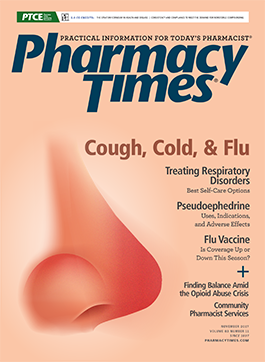How Brown Bag Sessions and Medication Therapy Management Promote Trust
Brown bag sessions and medication therapy management (MTM) can greatly help patients with chronic diseases.
Brown bag sessions and medication therapy management (MTM) can greatly help patients with chronic diseases. Offering to review a patient’s medications allows the pharmacist to personally connect with patients by serving as a trusted professional in the community. By reviewing prescription medications along with OTC drugs, herbal supplements, and vitamin and mineral supplements, pharmacists can educate, assess safety, prevent errors, and maximize quality of care. The sessions, such as the one described below, can be offered every day to select patients who seem to need follow-up care in addition to a typical counseling session.
Patients battling cancer should not be overlooked in the community pharmacy. Many of these patients need support, encouragement, and care coordination. They will endure a grueling process of coping with their diagnosis, treatment, and, in cases of recovery, the fear of recurrence. All these stages affect the patient both emotionally and physically. As the most accessible member of the health care team, the pharmacist can provide patients with cancer with information and support as they manage what may be the most challenging time of their lives. Willingness to help at this crucial time demonstrates caring and concern that patients will likely never forget.
THE CASE
DR is a 55-year-old woman who gets prescriptions filled for herself and her family at your community pharmacy. Recently, after a breast cancer diagnosis, she became a patient at the oncology clinic across from your pharmacy. DR frequently stops in to pick up refills and has experienced many emotional ups and downs related to her diagnosis and treatment. She presents you with a new list of medications and her laboratory data. DR says that she just left the clinic, and these are her most up-to-date documents.
You page through the papers and notice a medication reconciliation performed by the on-site clinic pharmacist. You compare it with her profile at your pharmacy and notice changes. As you conduct your review, you see the concern and confusion on her face. You explain the concept of pharmacy brown bag and MTM sessions and ask DR if she would be interested. She looks relieved and tells you that she will bring in all her oral medications the following day.
DR is looking forward to the opportunity to go over her entire history and medication list. She has been feeling confused and mildly depressed. She is also anxious about the anticipated adverse effects of oncology medications and how her diagnosis will affect her quality of life, because she still works. You suggest that she visit about 2 pm, which is a slower time at your pharmacy; plus, an additional pharmacist will be there to help cover urgent cases. This will allow you to provide DR with the best service and care.
The next day, DR is waiting in your consultation area. Having done your homework, you have filled her new medications, reviewed discontinued ones, and opened her medication profile, and you have access to her laboratory data and medication reconciliation. You compare what is in her brown bag to your information.
On reviewing DR’s medication profile at your pharmacy, you find the following:
- Aspirin 81 mg (enteric coated) daily
- Atenolol 25 mg daily
- Atorvastatin 10 mg daily
- Ibuprofen 600 mg twice daily as needed
- Letrozole 2.5 mg daily
- Niaspan 500 mg daily at bedtime
- Palbociclib 75 mg daily for 21 days (from specialty pharmacy)
In DR’s brown bag, you find these additional medications:
- Alprazolam 1 mg as needed
- Atorvastatin 20 mg daily
- Ondansetron 4 mg as needed
- OTC acetaminophen 500 mg as needed
- OTC loperamide as needed
- OTC omeprazole 20 mg daily
- Supplemental niacin
- Tamoxifen 20 mg daily
The goal of a brown bag session is to discover discrepancies.
Awareness allows you to make several short- and long-term suggestions, which may foster better communication between DR and her providers. This may improve her quality of life, avoid unnecessary appointments, and reduce her risk of hospital admissions. DR is willing to have you act as a community liaison between her and her providers. The first step is to follow up with them to make them aware of your discoveries and suggestions regarding DR’s plan of care. Time will be your biggest challenge. You must find a way to incorporate these clinical opportunities into your workflow, but loyalty and patient satisfaction are priceless and it is worth the energy to help DR.
What are some general suggestions you have after reviewing DR’s medications? What laboratory data might have helped you with the review? What questions do you have for the oncology clinic pharmacist?
DR needs more counseling and follow-up care. Considering time restrictions, how can you help ensure that she doesn’t fall off the track toward a better quality of life? What else would you suggest to DR before her MTM session?
Editor’s note: Case is not based on an actual patient.
Jill Drury, PharmD, works as a clinical pharmacy specialist in Chicago, Illinois, and Milwaukee, Wisconsin. She earned her doctor of pharmacy degree from Midwestern University College of Pharmacy. Her blog, Compounding in the Kitchen, an innovative amalgam of pharmacy and cooking, appears on PharmacyTimes.com/blogs/compounding-in-the-kitchen.

